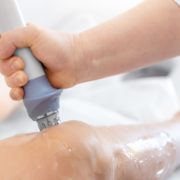Four Non-Invasive Ways to Get Rid of Arthritic Knee Pain
Knee arthritis is one of the most common and debilitating forms of joint pain affecting adults over 50. It’s a condition that slowly wears down the protective cartilage in your knee joint – leading to stiffness, swelling, and pain that can make even simple activities like walking the dog or climbing stairs feel like a chore.
While conventional treatments like traditional physical therapy, cortisone injections, and pain medication have been used for years to offer temporary relief – they don’t always work for everyone – and they fail to address the root cause . The good news is that there are several non-invasive, natural, and cutting-edge alternatives that go beyond masking symptoms and instead aim to support your body’s ability to heal and repair itself – especially when traditional treatments have come up short.
Corrective, Therapeutic Movement Strategies:
Perhaps the most accessible (and free) non-invasive solution is movement. Now, it might sound counterintuitive – and even laughable – to consider this as a viable strategy for arthritic knee pain, especially when your knee hurts. But not all arthritic knee pain is due to the arthritis itself.
Let me explain.
Much of the pain you experience when you’ve got arthritis is due to joint immobility and the compensatory patterns that develop over time. When you can identify these faulty movement patterns—and correct them with specifically prescribed therapeutic movement strategies designed to fix the mechanics in your knee joint – you can get significant pain reduction in your arthritic knee. You’ll need to work with a specialist to figure out which specific movements (or set of movements) your knee needs, but once you know what they are, you can use them forever to manage your knee pain – and it won’t cost you a dime.
Weight Management
Extra weight – even just a few pounds – can significantly increase the load placed on your knees when you’re walking, climbing stairs, and moving through your day. In fact, research from Dr. Stephen Messier and colleagues at Wake Forest University found that for every pound of weight lost, there is a four-pound reduction in knee joint stress during daily activities. In other words, losing just 10 pounds can reduce pressure on your knees by a remarkable 40 pounds with every step you take. Healthy, manageable weight loss – through a combination of smart nutrition and regular activity – can make a meaningful difference in pain levels and joint function. And the benefits aren’t limited to your knees. Losing weight reduces mechanical strain throughout your body, supporting the health and longevity of other joints as well.
Adopt an Anti-inflammatory lifestyle
While most people associate knee arthritis with “wear and tear,” it’s also a condition fueled by chronic inflammation. When you reduce inflammatory triggers – especially through your diet – it can lead to noticeable improvements in how your knees (and other joints) feel. Eating more whole, unprocessed foods that are rich in omega-3 fatty acids, antioxidants, and healthy fats is a powerful way to calm inflammation naturally. Aim to incorporate fatty fish like salmon, sardines, and mackerel at least twice per week, along with daily servings of dark leafy greens (like spinach and kale), berries, walnuts, chia seeds, and extra virgin olive oil. Spices like turmeric and ginger have natural anti-inflammatory properties and can easily be added to meals or smoothies.
On the flip side – it’s important to avoid refined sugars, processed grains (such as white bread and pastries), and fried foods – which are all known to promote inflammation. Beyond food, other daily habits that support lower inflammation include getting 7–8 hours of quality sleep, managing stress with activities like deep breathing or walking in nature, and drinking enough water – typically half your body weight in ounces per day. These foundational habits not only help reduce knee pain – but they’ll support your overall health and energy levels as well.
Explore non-invasive Regenerative Therapy
One of the most exciting technologies to hit the market in recent years – and that’s quickly gaining popularity – is the use of non-invasive regenerative therapies like Shockwave Therapy and EMTT. What I love about these treatment options is that they work with (not against) your body’s natural healing ability to regenerate degenerated or inflamed tissue – a major contributor to the pain and stiffness associated with knee arthritis. Shockwave Therapy uses mechanical sound waves to increase blood flow, break down scarred or damaged tissue, and reawaken dormant healing cells in the affected area. EMTT (Extracorporeal Magnetotransduction Therapy), on the other hand, uses high-frequency electromagnetic energy to reduce inflammation at the cellular level – boosting mitochondrial activity, improving cellular metabolism, and accelerating tissue repair. It’s particularly effective at targeting bone marrow lesions and chronic joint inflammation – both of which are commonly seen in knee arthritis.
While each of these therapies can be effective on its own, recent studies have shown that using EMTT and Shockwave together significantly enhances treatment outcomes. A 2021 clinical study published in Orthopedic Reviews found that the combination of EMTT and Shockwave Therapy led to greater improvements in pain relief and functional mobility compared to either treatment alone – while also providing longer-lasting results. For individuals who have already tried traditional physical therapy or cortisone injections without success – this combination of cutting-edge technology offers a powerful, drug-free solution that doesn’t just mask symptoms – it promotes actual healing.
Take Control of your Knee Pain – Naturally
If you’re struggling with knee arthritis and feel like you’ve tried everything – don’t give up hope. Medications and injections aren’t your only options. And surgery does not have to be your next step. By combining strategic movement, healthy weight management, anti-inflammatory lifestyle choices, and cutting-edge non-invasive regenerative therapies – it’s absolutely possible to reduce knee pain and reclaim your mobility naturally – without having to rely on pills, injections, or surgery. The key is finding the right combination that works for you – and being proactive about exploring alternatives that go beyond standard prescriptions and treatment strategies.
Are you local to Portsmouth, NH?
If so, consider speaking to one of my specialists for free by CLICKING HERE.
Dr. Carrie Jose, Physical Therapy Specialist, and Mechanical Pain Expert, owns CJ Physical Therapy & Pilates in Portsmouth, NH, and writes for Seacoast Media Group. If local to Portsmouth, NH, and looking for help – request a FREE Discovery Visit with one of her Specialists by CLICKING HERE.











